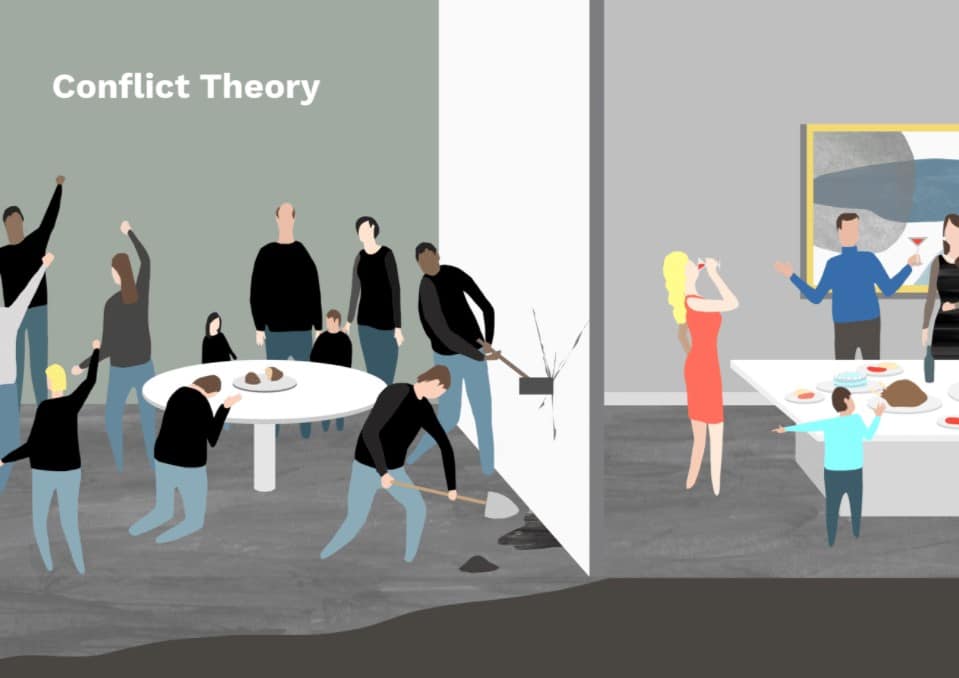Social Conflict theory in sociology explains society’s trend to change and grow due to endless conflict between courses. It’s among the four paradigms of sociology, which include functionalism, symbolic interactionism, and feminism. Cases of social conflict theory can be found in a variety of situations.

Origin and Background of Social Conflict Theory:
The 19th-century philosopher and revolutionary Karl Marx saw society divided into two classes: the proletariat (working class) and bourgeoisie (owners of the means of production).
Into Marx, social conflicts arise due to competition for limited funds in an economy, leading to an eventual revolution or warfare. Ruling classes maintained working classes in countries of oppression with hegemony, which enforced dominance with societal rules that all obeyed.
Political economist Max Weber extended this definition to include multidimensional class amounts, like those based on race, gender, and faith. He considered that in addition to political revolution, social conflict and change can result from discourse and the exchange of thoughts.
Real-Life Cases of Social Conflict Theory:
Patterns of class conflict theory happen when one class of individuals is systemically empowered over another. The less empowered class requires a share of tools that the more fortunate course has in abundance, leading to social conflict. Here are a few real-life examples of conflict concepts in both economic and societal scenarios.
Occupy Wall Street
Part of the backlash following the 2008 economic catastrophe, Occupy Wall Street was a two-month political protest on Wall Street, New York. Its motto, “We’re the 99%” referred to the rising prosperity and earnings discrepancy between the wealthiest 1% of the population and the rest of the country. Time Magazine called “The Protester” both global protesters and those involved in Occupy Wall Street, as its 2011 Individual of the Year.
The Education System
Inherent monitoring systems in the public schooling system produce their own course stratification. Gifted and advanced students (who are far more likely to be from households with time and financial tools which help instructional success) receive abilities that prepare them for college and future careers.
Average-performing pupils and struggling students do not obtain these same opportunities in their classes, which are often more focused on remediation and learning trades. If these students can make it to school, they will be economically disadvantaged because of student loans. This conflict has led to a national dialog about the affordability of college as well as also the feasibility of canceling student loan debt.
The Criminal Justice System
Crimes committed by members of wealthier groups, such as powerful CEOs or actors, frequently receive less punishment than offenses committed by people of minority races or lower socioeconomic status. Marx claimed that since the definition of crime and criminality is ordered by people that have societal energy, the criminal justice system is another means to subjugate the working class when elevating the higher course.
Another way for judgment classes to oppress others is to misuse the power they hold over women and men in subordinate careers. The Me Too movement, which began in 2006 and also had a social media resurgence in 2017 as #metoo, identified how widespread the issue of workplace sexual abuse and harassment had become. This sort of societal revolution reflects the inevitability that both Marx and Weber called when writing about the conflict concept.
Race and Black Lives Issue.
Sociologist W.E.B. Dubois explored double-consciousness, that’s the sensation of having two identities (in his case, an American and a black American) that are treated otherwise. Through his formation of Racial Formation Theory, Dubois claimed that racism in America was systemic — which a single racist was not needed to maintain the discriminatory system.
Black Lives Issue is a social movement that protests violence against black people. The motion’s supporters continue to demonstrate when black men and women are murdered in situations that are considered to be non-threatening.
Much like the civil rights movement that came more than 60 decades before, the Black Lives Issue is just another illustration of a social revolution following years of unequal treatment.
More For You:
What Is a Correlational Study And Examples of correlational research
Experimental strategy and essay-writing
How School Counselors Can Help Improve Mental Health In The Classroom